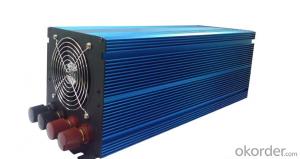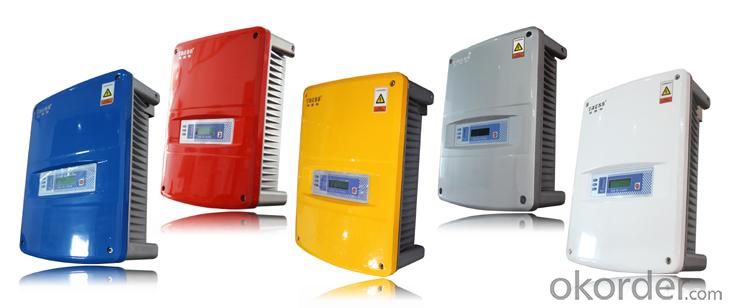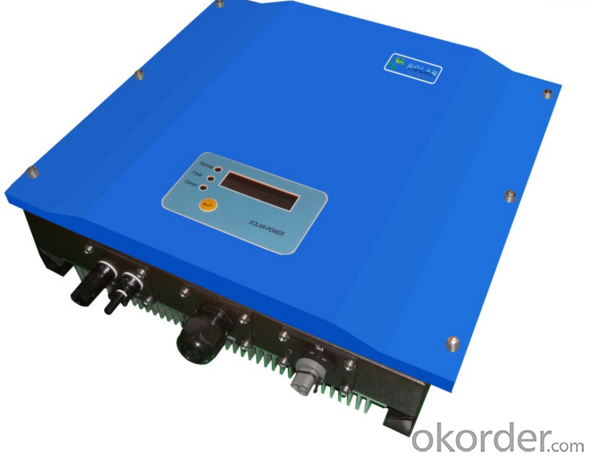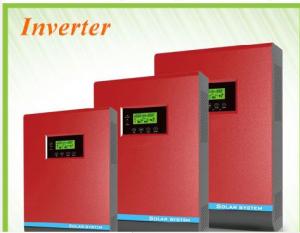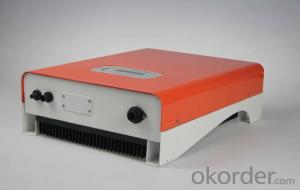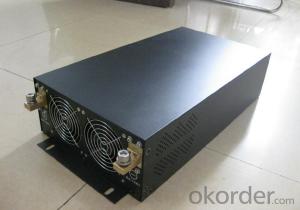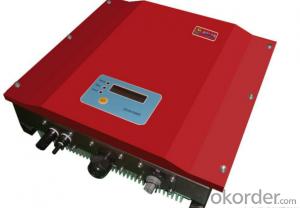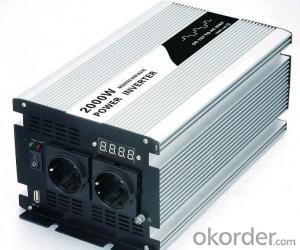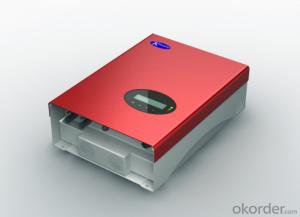Microtek Solar Inverter - Three Phase 6k Solar Inverter Made in China
- Loading Port:
- Shanghai
- Payment Terms:
- TT OR LC
- Min Order Qty:
- 0 watt
- Supply Capability:
- 10000 watt/month
OKorder Service Pledge
OKorder Financial Service
You Might Also Like
Description of Three Phase 6k Solar Inverter
Solar ac power system consists of solar panels, charge controllers, inverter and battery; Solar energy does not include inverter dc power system. Inverter is a kind of power conversion device, inverter by incentives can be divided into self-excited oscillation inverter and separately excited oscillation inverter.
Features of Three Phase 6k Solar Inverter
Standard 10 years warranty, 5-15 years optional
Built-in Gprs as option
Built-in Wifi as option
External Inductor
Smaller and lighter, only 22kg
High performance DSP for algorithm control
VDE-AR-N 4105 certification
New topology design
Dual MPPT design
IP65 waterproof and dustproof level
Multi-button touch interface
LCD screen visible at night
Have anti-shading function
Advantages of Three Phase 6k Solar Inverter
Longer life cycle
Plug and play
Free monitoring through our webportal
Very lower internal temperature
Easy transportation and installation
Faster CPU speed
Adjustable active and reactive power
Maximum conversion effciency up to 97.6%,Euro up to 96.8%
More flexible system design
Maximized system profit
User friendly operation
24 hour operation data readable on screen
Suitable to complex installation environment
Technical Data of Three Phase 6k Solar Inverter
| Type | Omniksol-6k-TL2 |
| Input(DC) | |
| Max.PV Power | 6150W |
| Max,DC Voltage | 1000V |
| Nominal DC Voltage | 640V |
| Operating MPPT Voltage Range | 150-800V |
| MPPT Voltage Range at Nominal Power | 280-800V |
| Start up DC Voltage | 250V |
| Turn off DC Voltage | 150V |
| Max, DC Current(A/B) | 11A/11A |
| Max, Short Cicuit Current for each MPPT | 16A/16A |
| Number of MPP trackers | 2 |
| Max, Input Power for each MPPT* | 4000W |
| Number of DC Connection | A:2/B:2 |
| DC Connection Type | MC4 connector |
| Output(AC) | |
| Max,AC Apparent Power | 6000VA |
| Nominal AC Power (cos phi = 1) | 6000W |
| Nominal AC Current | 8.7A |
| Nominal AC Voltage | 3/N/PE;220/380V |
| 3/N/PE;230/400V | |
| 3/N/PE;240/415V | |
| Nominal Grid Frequency | 50Hz/60Hz |
| Max, AC Current | 10.7A |
| Grid Voltage Range** | 185-276V |
| Grid Frequency Range** | 45-55Hz/55-65Hz |
| Power Factor | 0.9 capacitive... 0.9 inductive |
| Total Harmonic Distortion(THD) | <2% |
| Feed in Starting Power | 30W |
| Night time Power Consumption | <1W |
| Standby Consumption | <10W |
| AC Connection Type | Plug-in connertor |
| Efficiency | |
| Max,Efficiency | 97.6% |
| Euro Efficiency | 96.8% |
| MPPT Efficiency | 99.9% |
| Safety and Protection | |
| DC Insulation Monitoring | Yes |
| DC Switch | Optional |
| Residual Current Monitoring Unit (RCMU) | Integrated |
| Grid Monitoring with Anti-islanding | Yes |
| Electricity Fuse Protection | Yes |
| Protection Class | Ⅰ(According to IEC 62103) |
| Overvoltage Category | Ⅲ(According to IEC 62109-1) |
| Reference Standard | |
| Safety Standard | EN 62109, AS/NZS 3100 |
| EMC Standard | EN 6100-6-1, EN 6100-6-2, EN 6100-6-3 EN 6100-6-4, EN 6100-3-2, EN 6100-3-3 |
| Grid Standard | VDE-AR-N4105. VDE-0126-1-1,G83/1,EN 50438,RD1699,CEI 0-21, AS4777,C10/C11 |
| Physical Structure | |
| Dimensions | 352x421x172.5mm |
| Weight | 22kg |
| Environmental Protection Rating | IP 65 (According to IEC 60529) |
| Cooling Concept | Natural convection |
| Mounting Information | Wall bracket |
| General Data | |
| Operating Temperature Range | -25℃ to +60℃(derating above 45℃) |
| Relative Humidity | 0% to 98%, no condensation |
| Max. Altitude (above sea level) | 2000m |
| Noise Type | <40dB |
| Isolation Type | Transformerless |
| Display | 20 x 4 LCD (800x480 TFT Graphic Display optional) |
| Data Communication | RS485(WiFi, GRPS optional) |
| Computer Communication | USB |
| Standard Warranty | 10 Years (5-15 years optional) |
IMages of Three Phase 6k Solar Inverter

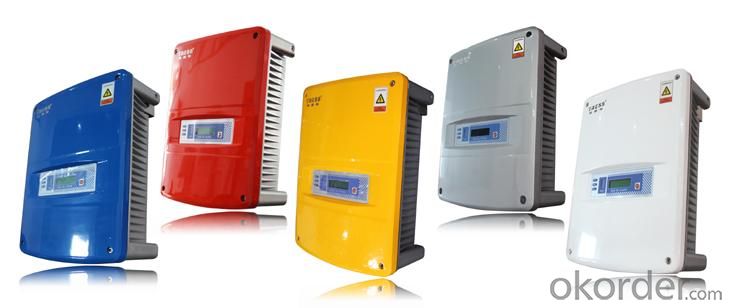
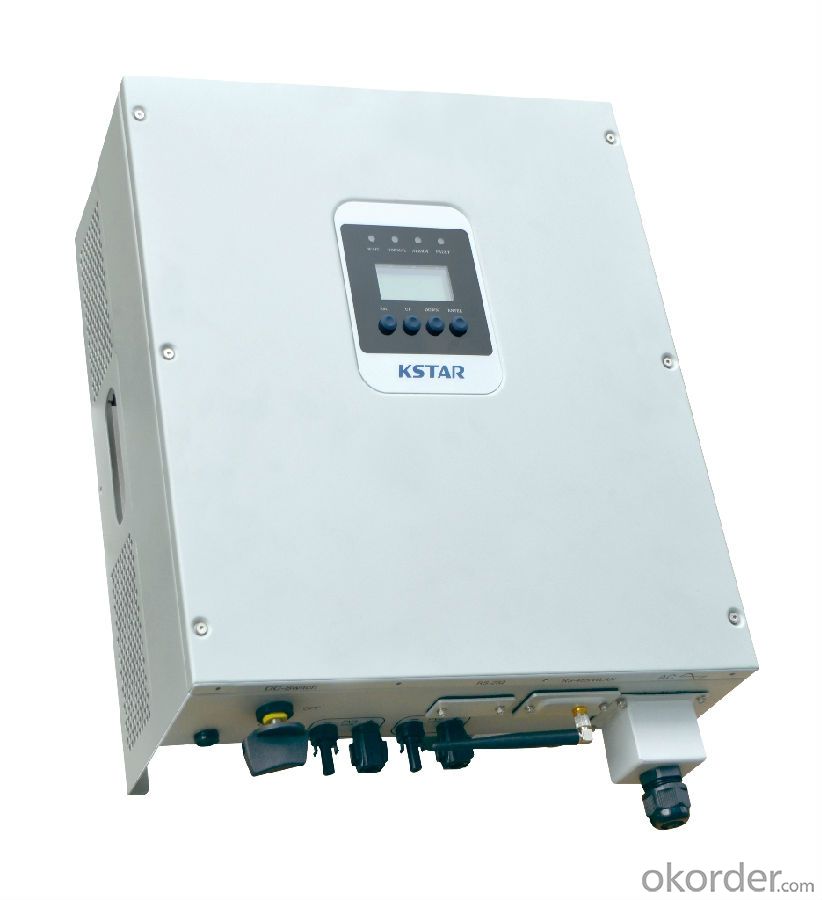
FAQ
Q: Do you have the CE, TUV, UL Certification?
A: We’ve already passed all the tests, and any certificate is available.
Q: Have you ever sold your products to companies in my country?
A: Of course, we have customers in all general PV markets, but I think we should expand our market share along with the market growth.
Q: When did your company set up? You are a new company, how can I believe your quality?
A: We entered into Solar PV industry in 2005, now we have several plants in manufacturing of a-Si and c-Si panels, and our capacity is 220MW per year. Till now we have already passed all the tests by authorized laboratories, e.g. TUV, CE, UL.
Q: Can you help us install the module if we cooperate with you?
A: We haven’t entered into installation sector, but we have the plan in near future.
Q: How do you pack your products?
A: We have rich experience on how to pack the panels to make sure the safety on shipment when it arrives at the destination.
Q: Can you do OEM for us?
A: Yes, we can.
Q: Can we visit your factory?
A: Surely, I will arrange the trip basing on your business schedule.
- Q: Can a solar inverter be used in harsh environmental conditions?
- Yes, solar inverters are designed to withstand harsh environmental conditions such as extreme temperatures, high humidity, and exposure to dust, dirt, and corrosive elements. They are built with robust materials and undergo rigorous testing to ensure their durability and reliability in challenging environments. Additionally, some solar inverters come with IP65 or higher ratings, indicating their resistance to water and dust ingress, making them suitable for installation in outdoor and harsh conditions.
- Q: Can a solar inverter be used with dual-axis solar trackers?
- Yes, a solar inverter can be used with dual-axis solar trackers. The dual-axis solar trackers continuously adjust the position of the solar panels to optimize sun exposure throughout the day. The solar inverter is responsible for converting the DC power generated by the solar panels into AC power for use in residential or commercial applications. Therefore, the solar inverter can be easily integrated with dual-axis solar trackers to ensure efficient power generation and utilization.
- Q: What is the importance of insulation resistance measurement in a solar inverter?
- Insulation resistance measurement in a solar inverter is crucial as it helps ensure the safety and efficiency of the electrical system. By measuring the insulation resistance, any potential faults or deteriorations in the insulation can be detected, preventing electrical leakage or short circuits. This measurement also helps identify any insulation breakdowns that may compromise the performance and reliability of the solar inverter. Ultimately, insulation resistance measurement is essential for maintaining the integrity of the solar inverter and ensuring the safety of both the electrical system and the people using it.
- Q: Can a solar inverter be used with solar-powered water heaters?
- No, a solar inverter cannot be used with solar-powered water heaters as they operate on different principles. Solar inverters are designed to convert the direct current (DC) generated by solar panels into alternating current (AC) for use in residential or commercial electrical systems. On the other hand, solar-powered water heaters use sunlight directly to heat water, without the need for converting DC to AC. Therefore, these two systems are not compatible with each other.
- Q: Can a solar inverter be used with different types of power control devices?
- Yes, a solar inverter can be used with different types of power control devices. Solar inverters are designed to convert the direct current (DC) generated by solar panels into alternating current (AC) that can be used to power household appliances and other electrical devices. They can be integrated with various power control devices such as charge controllers, battery banks, and grid-tie systems to optimize the energy output and manage the flow of electricity efficiently.
- Q: Can a solar inverter be used with a hybrid solar power system?
- Yes, a solar inverter can be used with a hybrid solar power system. A hybrid solar power system typically consists of both solar panels and a secondary power source, such as batteries or a diesel generator. The solar inverter converts the direct current (DC) power generated by the solar panels into alternating current (AC) power that can be used to power appliances and devices in the home or business. Additionally, the solar inverter can also manage the flow of power between the solar panels, the batteries, and the grid, optimizing energy usage and ensuring a reliable power supply.
- Q: Are there any maintenance requirements for solar inverters?
- Yes, solar inverters do require regular maintenance to ensure optimal performance and longevity. This can include cleaning or replacing air filters, inspecting and tightening electrical connections, checking for any physical damage or corrosion, and updating firmware or software as needed. Additionally, monitoring the inverter's performance and generating reports can help identify any issues or inefficiencies that may require maintenance or repairs.
- Q: Can a solar inverter be used in regions with high altitude conditions?
- Yes, a solar inverter can be used in regions with high altitude conditions. However, it is important to consider certain factors such as temperature, air density, and potential voltage fluctuations that can affect the performance of the solar inverter at high altitudes. Specialized inverters or adjustments may be required to ensure optimal functioning in such conditions.
- Q: Are there any limitations on the angle of the solar panels when using a solar inverter?
- Yes, there are limitations on the angle of the solar panels when using a solar inverter. The angle at which solar panels are installed can affect their efficiency and overall performance. Ideally, solar panels should be installed at an angle that allows them to receive maximum sunlight throughout the day. Most solar panels are designed to work optimally when installed at an angle that is equal to the latitude of the location. This angle allows the panels to capture the most sunlight during peak hours. However, this is not a strict rule and variations are possible depending on the specific location and climate conditions. If solar panels are installed at an angle that is too steep or too shallow, it can result in reduced energy production. Steep angles may cause the panels to lose sunlight during certain times of the day, while shallow angles may not allow for optimal sunlight absorption. Additionally, extreme angles can also increase the risk of damage from wind or other weather conditions. It is important to note that modern solar inverters often come with advanced tracking and monitoring technologies that can adapt to different panel angles and orientations. These features can optimize energy production by adjusting the inverter settings based on the real-time performance of the panels. Overall, while there are limitations on the angle of the solar panels, it is crucial to ensure that they are installed in a way that maximizes their exposure to sunlight throughout the day to achieve the highest energy production possible.
- Q: Can a solar inverter be used with micro-inverters?
- Yes, a solar inverter can be used with micro-inverters. In fact, it is a common practice to combine a central solar inverter with micro-inverters in a solar system. The central inverter is responsible for converting the direct current (DC) power generated by the solar panels into alternating current (AC) power, while the micro-inverters optimize the power output of each individual solar panel. This combination allows for increased efficiency and flexibility in managing the solar system.
Send your message to us
Microtek Solar Inverter - Three Phase 6k Solar Inverter Made in China
- Loading Port:
- Shanghai
- Payment Terms:
- TT OR LC
- Min Order Qty:
- 0 watt
- Supply Capability:
- 10000 watt/month
OKorder Service Pledge
OKorder Financial Service
Similar products
Hot products
Hot Searches
Related keywords
